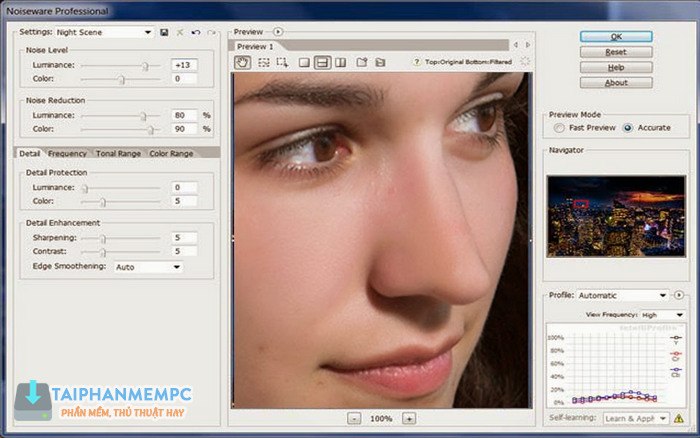

#Noiseware software
One of the tribulations of upgrading your software is making sure your indispensable utilities are not out of phase. We were impressed that Noiseware ran without a hiccup on the beta CS3 version of Photoshop.
#Noiseware iso
After several months of processing high ISO digicam images with it, we're ready to report on this tool, which has become indispensable to our workflow. Shortly after, a review copy arrived and we put Noiseware to work as a Photoshop plug-in.

What we liked immediately about Noiseware was that, unlike Dfine, it did not need a camera module and unlike Photoshop, it had a complete set of options for controlling noise.
#Noiseware professional
Then, at PMA last year, we sat down for a 15 minute demonstration of Imagenomic's Noiseware Professional (), a Photoshop plug-in to tackle the problem. Here the original is compared to the Default result. Image analysis occurs before the plug-in displays its window. Recent versions of Photoshop have included a Noise Reduction filter that works very well on any image and we tried that for a while. But that program requires a module for every camera you own. We had reviewed Nik Software's superb Dfine in our Aug. And we set out to see if there wasn't some tool that would make it feasible to shoot at high ISO and still expect quality results. Reminds us of grainy film.īut other reviewers felt the high ISO shots were simply unusable. We're big fans of natural light photography, hate those puny flashes that beam red-eye into everything and really don't mind a little noise. With so many new cameras hitting the store shelves last year, we took our turn reviewing a few digicams. You have to bear in mind how your image will be viewed and how much detail you are trading for noise reduction. And even worse, reducing noise can easily reduce detail. It can often be difficult to distinguish between noise and detail in an image, too. Noise, as false data, is the great enemy of detail. In-camera sharpening and increased contrast settings can, on the other hand, exaggerate noise. On high ISO images, however, it often isn't optional. One of those processes, often optional, is noise reduction. And it varies depending on the temperature of the sensor, too.Īnd even after the data is captured by the sensor, it is analyzed and processed by your camera's imaging chip.

Where it's really noticeable, we call it a hot pixel. Even without light, there may be a little current here and less there and none here. The photo sites on a sensor are not uniform. And this current is converted into data, somewhere between 0 and 255 units in an 8-bit channel. The more light, the more electrical current. Each sensor in your digicam's CCD is stimulated by light. They can be caused naturally by what's called dark current. Off-colored pixels are Chrominance Noise. Dark pixels in a lighter area are Luminance Noise. Data that didn't come from the scene.īut it's not a defect. And what's that magenta pixel doing in there? Instead of the smooth blue you think you shot, you've captured a mosaic of discount tiles that hardly match. What you see may make you reach for the phone to call tech support. When you print images, the data is resampled again for one or another type of print screen, minimizing the effect.īut enlarge your image 200 percent (just double size, that is) in your favorite image editor and take a look at the sky. When you review images on your LCD, the data has been resampled to fit on your screen so much the noise disappears. It's true that you don't typically notice noise. And image noise is starting to get noticed just like shutter lag once was: as a nuisance no one talks about. This year the trend toward higher ISOs has continued.

You really have to have a 3-megapixel digicam to avoid it. Some cameras do better than others, but as manufacturers cram more photo sites on tiny digicam sensors, the problem is unavoidable.
#Noiseware full
Our camera reviews, which include a full range of ISO shots, pointed out that above ISO 400, these images started to fall apart. In almost all cases, noise reduction was automatically applied to these high ISO images. And, for the most part, the increase was managed by turning up the volume, increasing the signal gain. ISO equivalents jumped from 400 to as high as 3200, with many models in the 1000 to 1600 range. The push, so to speak, was to enable more options for available light photography - and reduce any reliance on the pitiful little built-in flash. Last year several camera manufacturers significantly increased the sensitivity of their sensors even in some of the more affordable digicams. The Imaging Resource Digital Photography Newsletter AND MORE Noiseware - The Cure for High ISO By MIKE PASINI


 0 kommentar(er)
0 kommentar(er)
